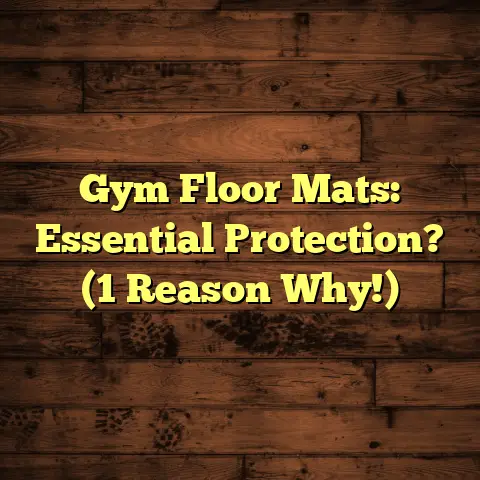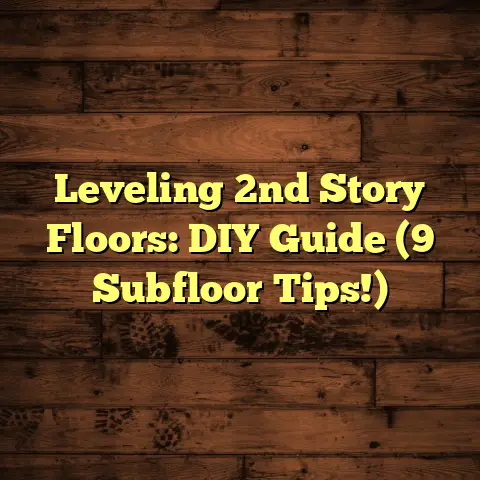Peel & Stick vs. Real Tile (5 Shocking Facts!)
Today, we’re diving deep into a topic that’s been buzzing around: peel & stick vs.
real tile.
Now, I know what you’re thinking: “It’s just
flooring, right?” Wrong!
Your flooring choice
impacts not only the look of your home, but also
the safety and well-being of your loved ones.
Before we get into the nitty-gritty, let’s talk
safety.
Flooring isn’t just about aesthetics; it’s
about ensuring a safe environment for everyone in
your home, from your energetic kids to your
grandparents.
Think about it: slip resistance is crucial,
especially in areas prone to moisture like kitchens
and bathrooms.
The materials themselves can also
pose risks.
Some contain harmful chemicals, while
others might not stand the test of time, leading to
tripping hazards down the road.
Both peel & stick and real tile have their own
safety profiles.
Peel & stick might seem like the
easier option, but are you truly aware of what
lurks beneath that sticky surface?
Real tile, on
the other hand, boasts impressive durability, but
can it also be a slippery slope?
Let’s uncover some eye-opening truths that’ll help you make the best decision for your home and your family.
Section 1: Shocking Fact #1 – Installation Safety
Okay, let’s get our hands dirty and talk installation.
Peel & Stick: Easy Peasy… Or Risky?
Peel & stick flooring is often touted for its
DIY-friendliness.
No messy mortar, no specialized
tools – just peel, stick, and voila!
But hold on
a second.
Think about the repetitive motions involved: bending,
kneeling, and applying pressure for extended periods.
This can lead to back strain, knee problems, and
even carpal tunnel syndrome.
I’ve seen it happen
to many homeowners who underestimated the physical
demands of even a small project.
Also, the adhesives in peel & stick tiles can
sometimes be irritating to the skin or respiratory
system.
Always ensure proper ventilation and wear
gloves during installation.
Real Tile: The Pro’s Domain (Usually)
Real tile installation is a whole different ballgame.
It requires skill, precision, and the right tools.
We’re talking wet saws, trowels, and a whole lot of
muscle.
The biggest hazards here are heavy lifting and
cutting.
Those tiles can be surprisingly heavy, and
a dropped tile can easily crush a toe (trust me,
I’ve been there!).
Wet saws, while efficient, can
be dangerous if not handled properly.
According to the CDC, falls are a leading cause of
injury for construction workers, and improper
lifting techniques contribute significantly to back
injuries.
While these statistics encompass all
construction work, they highlight the potential
risks associated with the heavy lifting involved in
real tile installation.
The Verdict?
Both installation methods have their risks.
Peel &
stick might seem safer initially, but the repetitive
motions can take a toll.
Real tile requires more
expertise and carries a higher risk of immediate
injury if not handled correctly.
My advice?
If you’re considering a large peel &
stick project, enlist a friend or family member to
help break up the work.
And for real tile, unless
you’re a seasoned DIYer, it’s best to leave it to
the professionals.
Section 2: Shocking Fact #2 – Chemical Composition and Indoor Air Quality
Now, let’s talk about what’s in these floors and how they affect the air you breathe.
Peel & Stick: The VOC Villain?
Peel & stick tiles are often made from vinyl, a
type of plastic.
And many vinyl products contain
VOCs (Volatile Organic Compounds).
VOCs are chemicals that evaporate at room
temperature.
They’re the culprits behind that
“new flooring smell,” but they can also cause
headaches, dizziness, and respiratory irritation.
Prolonged exposure to high levels of VOCs has even
been linked to more serious health problems.
The EPA has identified several VOCs commonly found
in building materials, including formaldehyde,
benzene, and toluene.
While manufacturers are
working to reduce VOC emissions, it’s still
essential to be aware of the potential risks.
Real Tile: Earth’s Embrace?
Real tile, on the other hand, is typically made from
natural materials like clay, stone, or porcelain.
These materials are generally considered to be low
in VOCs.
However, the grout used to install real tile can
also contain chemicals.
Some grouts contain
additives to prevent mold and mildew growth, and
these additives can sometimes release VOCs.
The Verdict?
Real tile generally wins in terms of chemical
composition.
However, it’s crucial to choose low-VOC
adhesives and grouts, regardless of the flooring
type you select.
Look for products that are certified by organizations
like GreenGuard or FloorScore.
These certifications
indicate that the product has been tested for VOC
emissions and meets strict standards.
Section 3: Shocking Fact #3 – Longevity and Wear
Let’s face it, no one wants to replace their
flooring every few years.
So, how do peel & stick
and real tile stack up in terms of longevity?
Peel & Stick: A Fleeting Fancy?
Peel & stick tiles are generally less durable than
real tile.
They’re prone to scratches, dents, and
peeling, especially in high-traffic areas.
I’ve seen countless peel & stick floors that start
to look worn and tired after just a year or two.
And once a tile starts to peel, it becomes a
tripping hazard.
Real Tile: The Timeless Titan?
Real tile, when properly installed and maintained,
can last for decades.
It’s incredibly resistant to
scratches, dents, and moisture.
Think about ancient Roman mosaics – they’re still
around today!
While your modern tile floor might
not last quite that long, it’s certainly a more
durable option than peel & stick.
However, even real tile isn’t indestructible.
It can
crack or chip if subjected to heavy impact.
And
worn grout can become a breeding ground for mold and
mildew, which can pose health risks.
The Verdict?
Real tile is the clear winner in terms of longevity.
While peel & stick might be a good option for a
temporary fix or a low-traffic area, it’s not a
long-term solution.
Remember, a worn or damaged floor is a safety
hazard.
Loose tiles, cracks, and uneven surfaces can
all lead to trips and falls.
Section 4: Shocking Fact #4 – Cleaning and Maintenance Safety
Alright, let’s talk about keeping these floors clean and safe.
Peel & Stick: A Cleaning Conundrum?
Peel & stick tiles can be tricky to clean.
Harsh
chemicals can damage the surface or loosen the
adhesive.
And excessive moisture can seep between
the tiles, leading to mold growth.
I’ve seen homeowners use abrasive cleaners on peel &
stick floors, only to end up with a dull, scratched
surface.
The best approach is to use a mild detergent
and a damp mop.
Real Tile: A Cleaning Champion?
Real tile is generally easier to clean than peel &
stick.
It can withstand stronger cleaners and more
vigorous scrubbing.
However, grout can be a challenge.
It’s porous and
prone to staining.
Regular sealing is essential to
prevent dirt and grime from penetrating the grout
lines.
Also, be careful with acidic cleaners on certain
types of tile, such as natural stone.
These cleaners
can etch the surface and cause permanent damage.
The Verdict?
Both types of flooring require regular cleaning and
maintenance.
But real tile is generally more
forgiving when it comes to cleaning products.
Regardless of the flooring type, always read the
manufacturer’s instructions before using any cleaning
product.
And be sure to test the product in an
inconspicuous area first to ensure that it doesn’t
damage the surface.
Also, remember that wet floors are slippery floors.
Always dry the floor thoroughly after cleaning to
prevent falls.
Section 5: Shocking Fact #5 – Resale Value and Safety Perception
Finally, let’s talk about how your flooring choice impacts the perceived value and safety of your home when it comes time to sell.
Peel & Stick: A Red Flag for Buyers?
Peel & stick flooring often has a negative impact on
resale value.
Many buyers perceive it as a cheap and
temporary fix.
I’ve heard real estate agents say that peel & stick
flooring can make a home feel dated or poorly
maintained.
And a potential buyer might wonder what
other corners were cut during renovations.
Real Tile: A Sign of Quality?
Real tile, on the other hand, is generally seen as a
sign of quality and durability.
It can add value to
your home and make it more appealing to potential
buyers.
I’ve seen homes with well-maintained tile floors sell for significantly more than comparable homes with cheaper flooring options.
The Verdict?
Real tile is the clear winner when it comes to resale
value and safety perception.
While peel & stick
might be a budget-friendly option, it can ultimately
cost you more in the long run.
Think of it this way: flooring is an investment.
Choosing a durable and aesthetically pleasing option
like real tile can pay off handsomely when you decide
to sell your home.
Conclusion: Summary and Implications
So, there you have it: 5 shocking facts about peel &
stick vs.
real tile.
Let’s recap:
- Installation Safety: Both options have risks,
but real tile requires more expertise. - Chemical Composition: Real tile is generally
lower in VOCs. - Longevity and Wear: Real tile is far more
durable. - Cleaning and Maintenance: Real tile is easier
to clean. - Resale Value: Real tile adds value, while
peel & stick can detract from it.
Ultimately, the best flooring choice for you depends
on your budget, your lifestyle, and your personal
preferences.
But remember, safety should always be a
top priority.
Don’t just think about how the floor looks; think
about how it will impact the health and well-being of
your family.
Choose wisely, and you’ll create a
beautiful and safe home for years to come.





